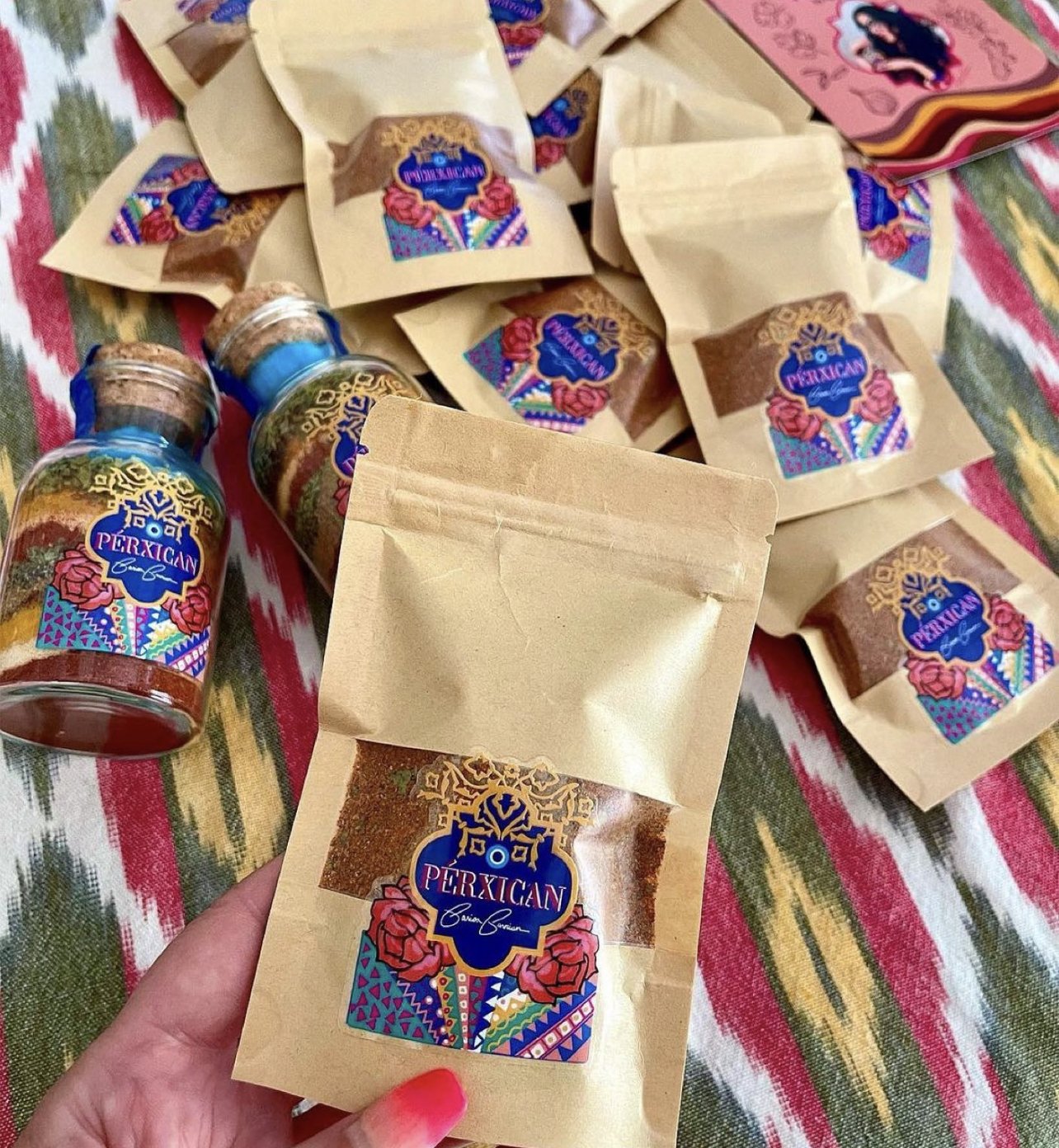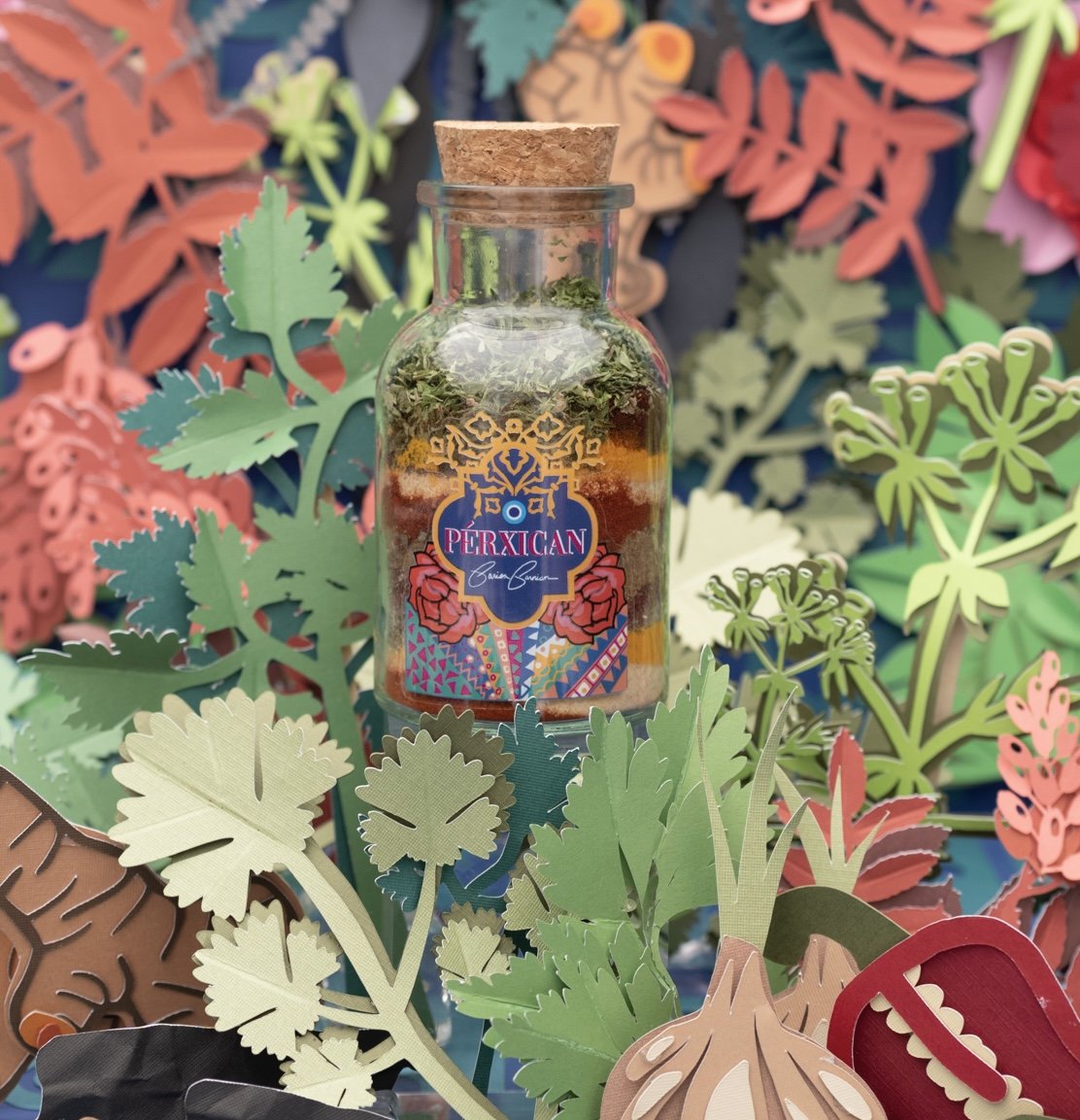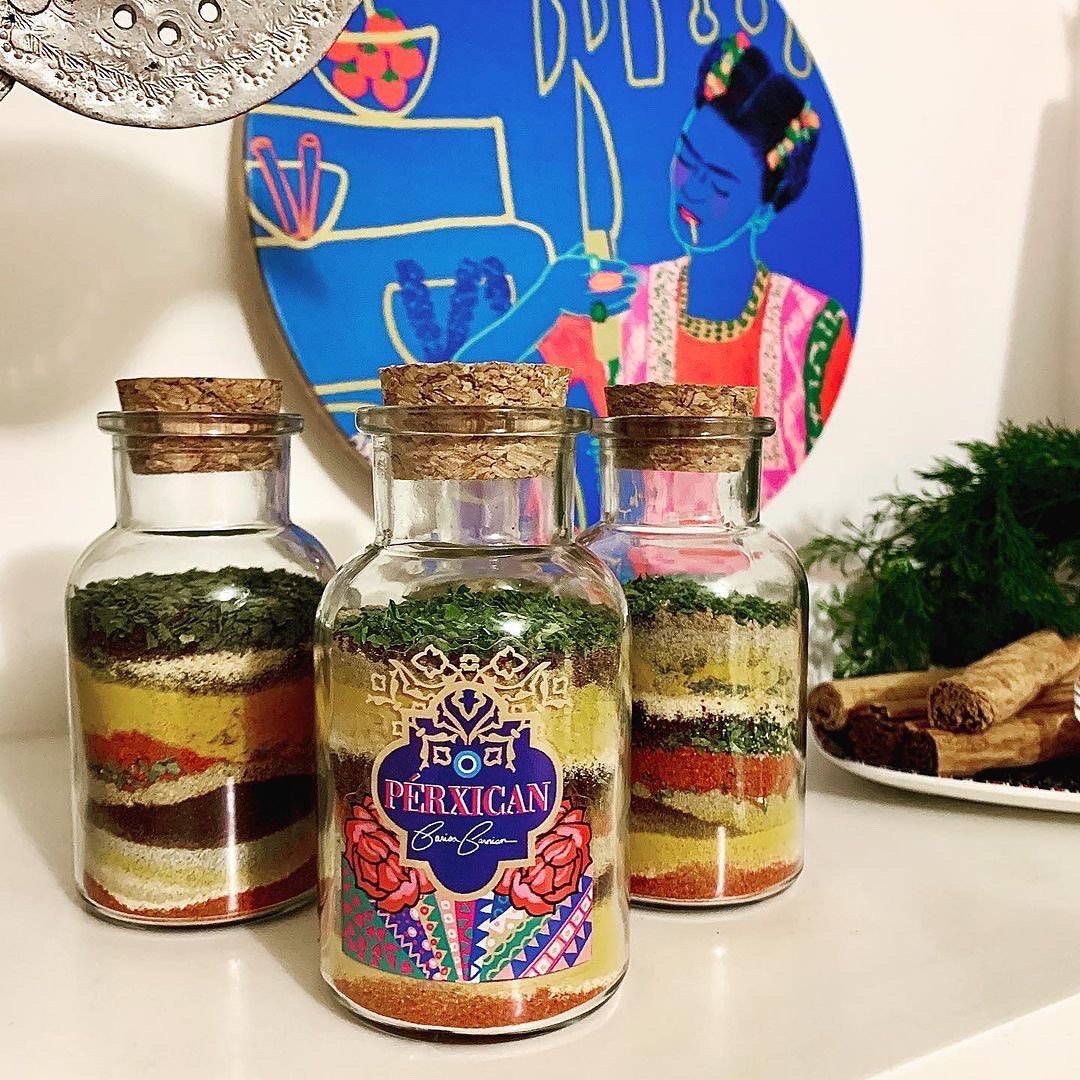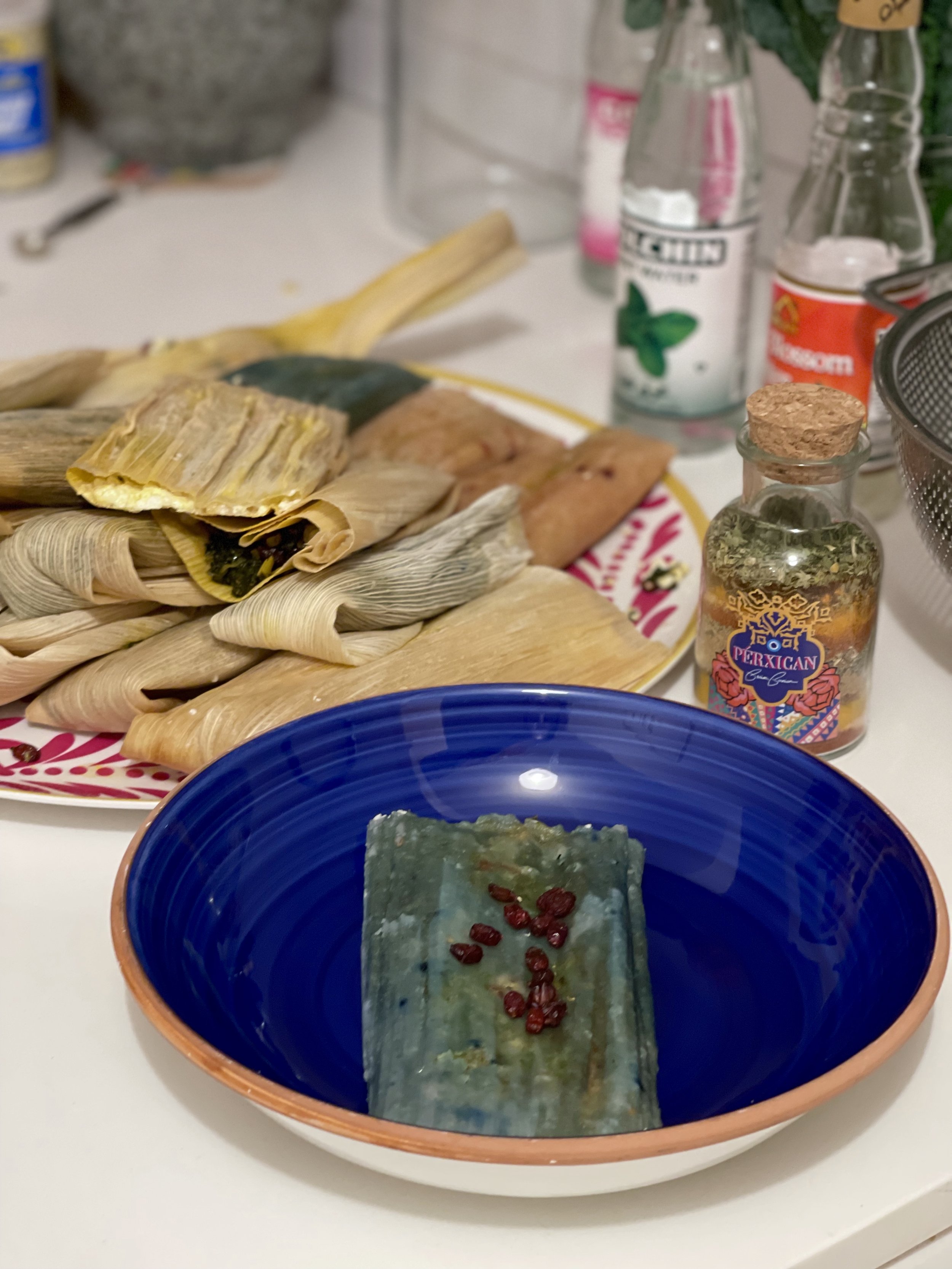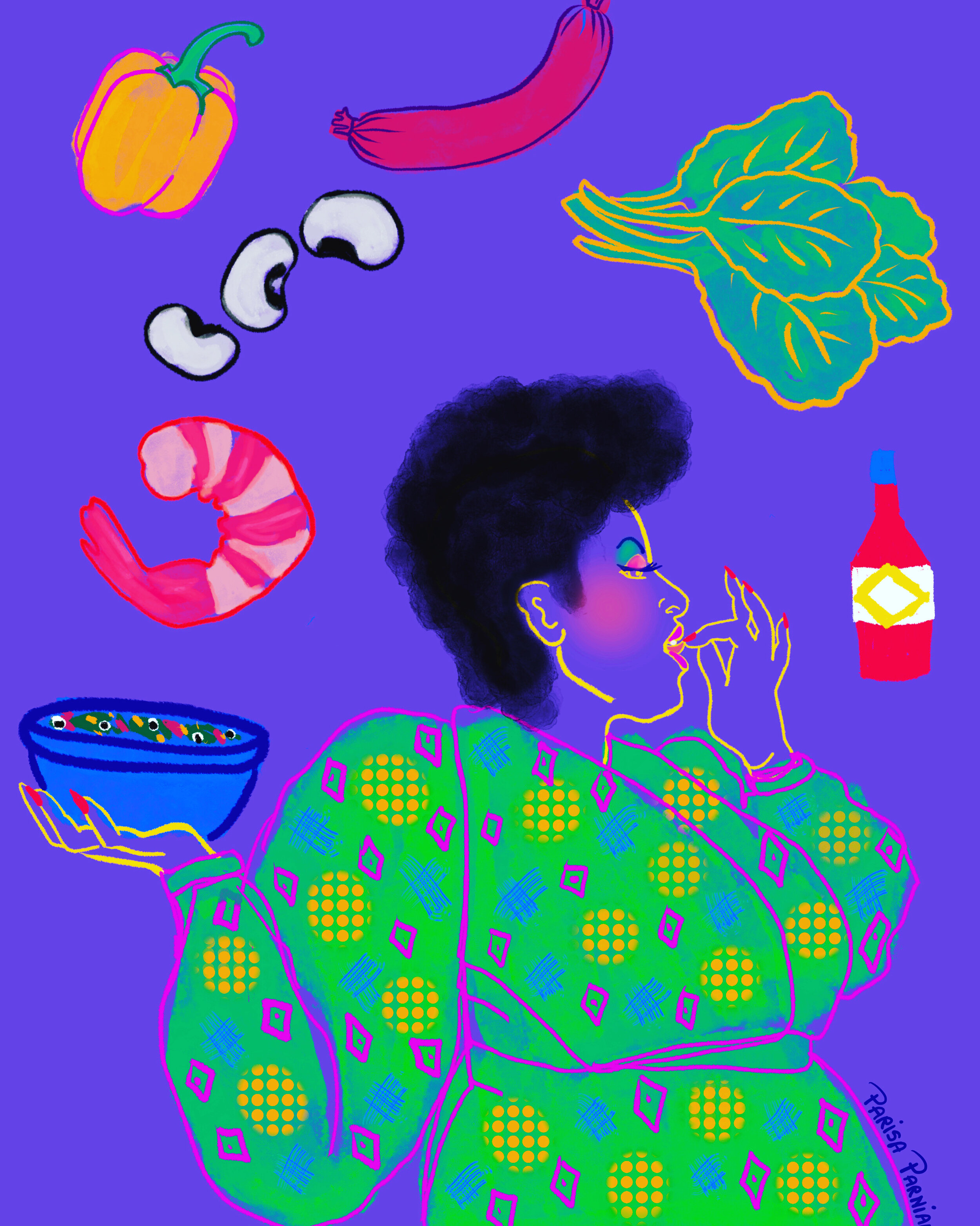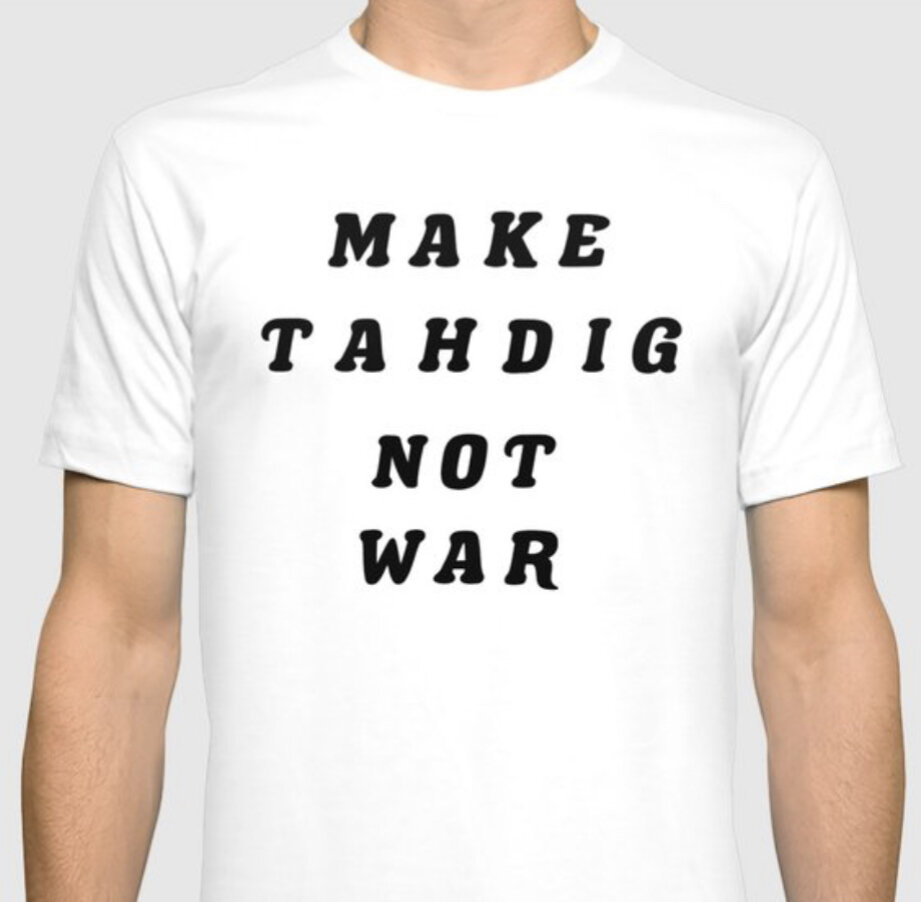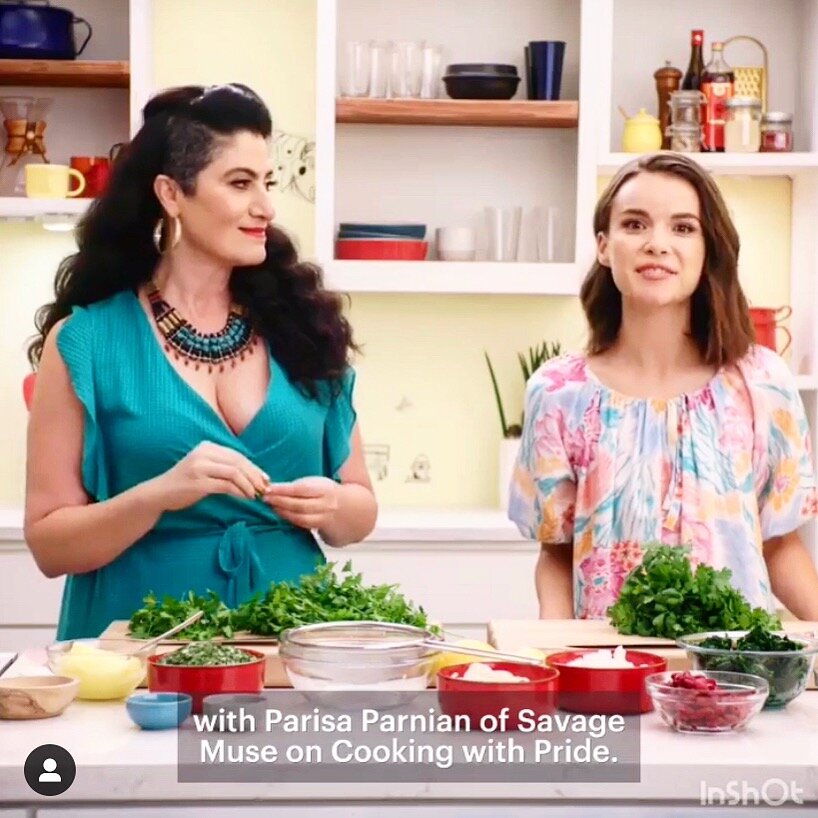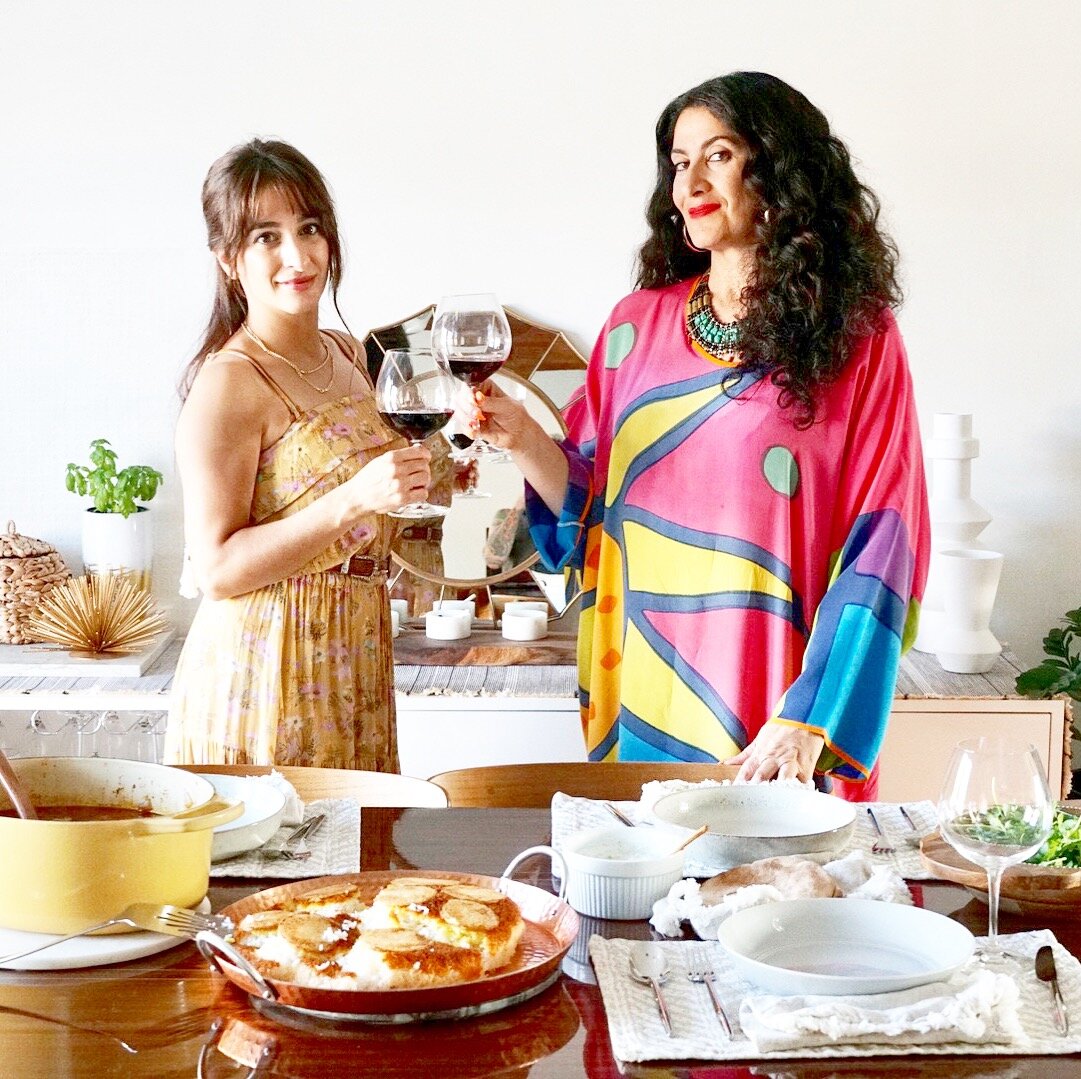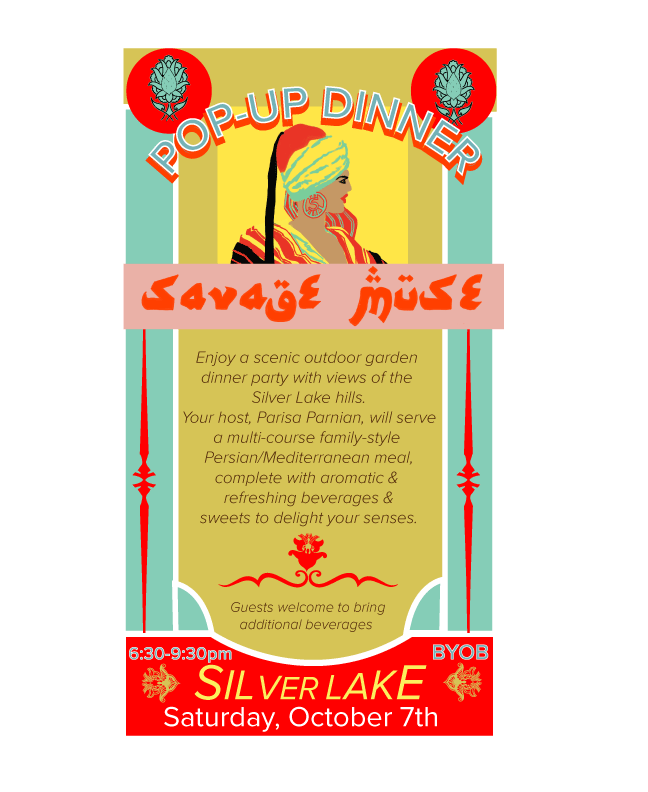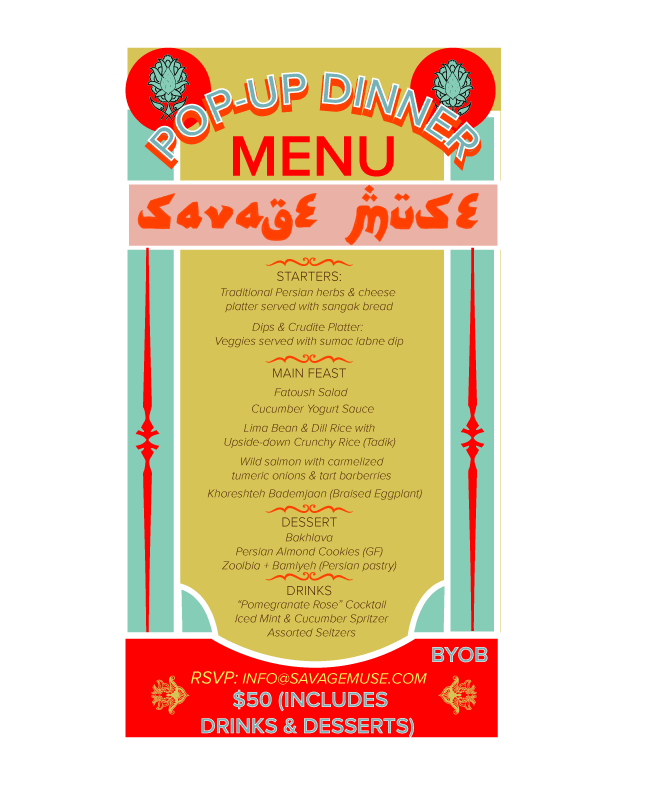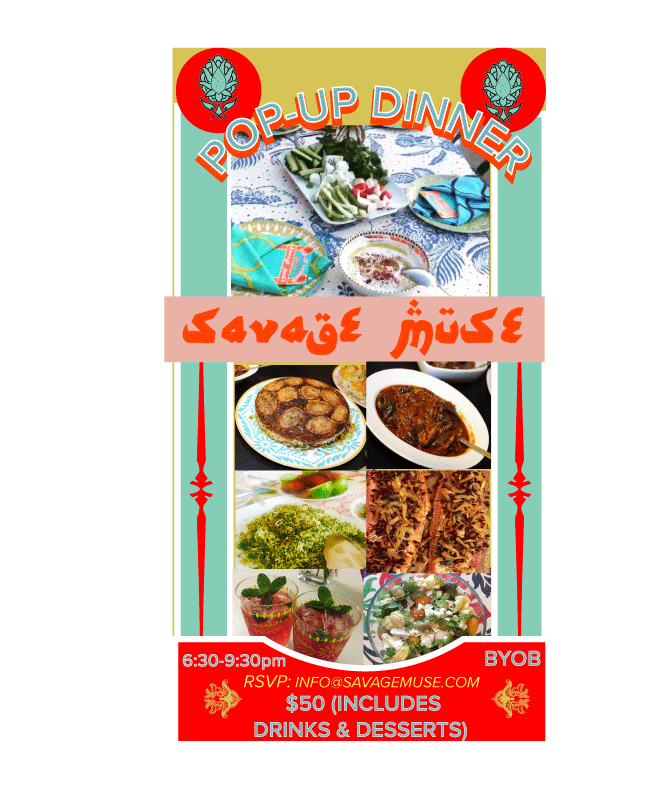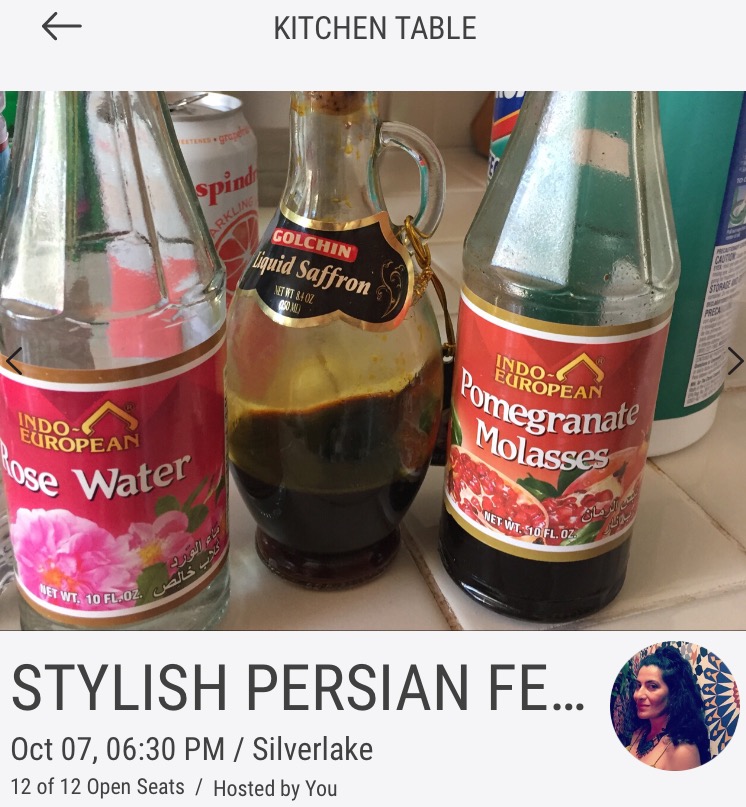The story behind why I created PÉRXICAN spice blend
The story behind why I created PÉRXICAN spice blend
Three years ago, the gorgeous Silver Lake building where I was hosting my Persian Supper + Salons in LA was sold and the new owners legally evicted the tenants, including me.
It was one of the most heart-breaking moments of my life because I was not only losing my affordable, rent-controlled home, but also the garage I had converted into my art studio, the outdoor space where I could host gatherings and the ability to continue my pop-up dinner series (featured in Eater LA).
When life gives you lemons, you make Persian Limonada
Given my budget for rent as a self-employed creative and LA’s escalating rent prices, what I could get for the same price as my former space was basically a bedroom inside of a shared home with others….which wasn’t going to work for me.
And so, I put all my belongings into storage and decided to go to a city I had never been to before but which had been calling my name like a mysterious and seductive siren: Mexico City.
What awaited me there would forever change the trajectory of my life and add even more layers to the already layered existence I had as an artist, cook and culture maker.
I spent the Fall of 2019 exploring the food, culture and people of Mexico City. Through one of my best friends and his husband, I met some of the city’s most interesting artists, gallery owners, designers and creatives. Through my own curiosity and appetite for culinary adventure, I met some of CDMX/s emerging chefs, food writers and restauranteurs. And because of my love of underground nightlife, I explored some of the city’s underground and subversive parties and events.
Connecting my Persian roots with my travels in Mexico
My explorations in Mexico City deserve their own post(s) but for now, let me get to the story of how this trip inspired the Persian-Mexican artistic spice blend I created in 2021 called PÉRXICAN. As I was navigating the bustling, colorful city streets of Roma Norte and Condessa, the two neighborhoods I spent most of my time in, I started to feel a vibe that I felt when I was a child walking thru the streets of Teheran.
Something about the tree-lined streets that gave a tranquil shade to a combination of both modern and Arabesque-style homes with their unassuming concrete walls and decorative iron gates took me back to Teheran, the city where I was born and spent the first four years of my life.
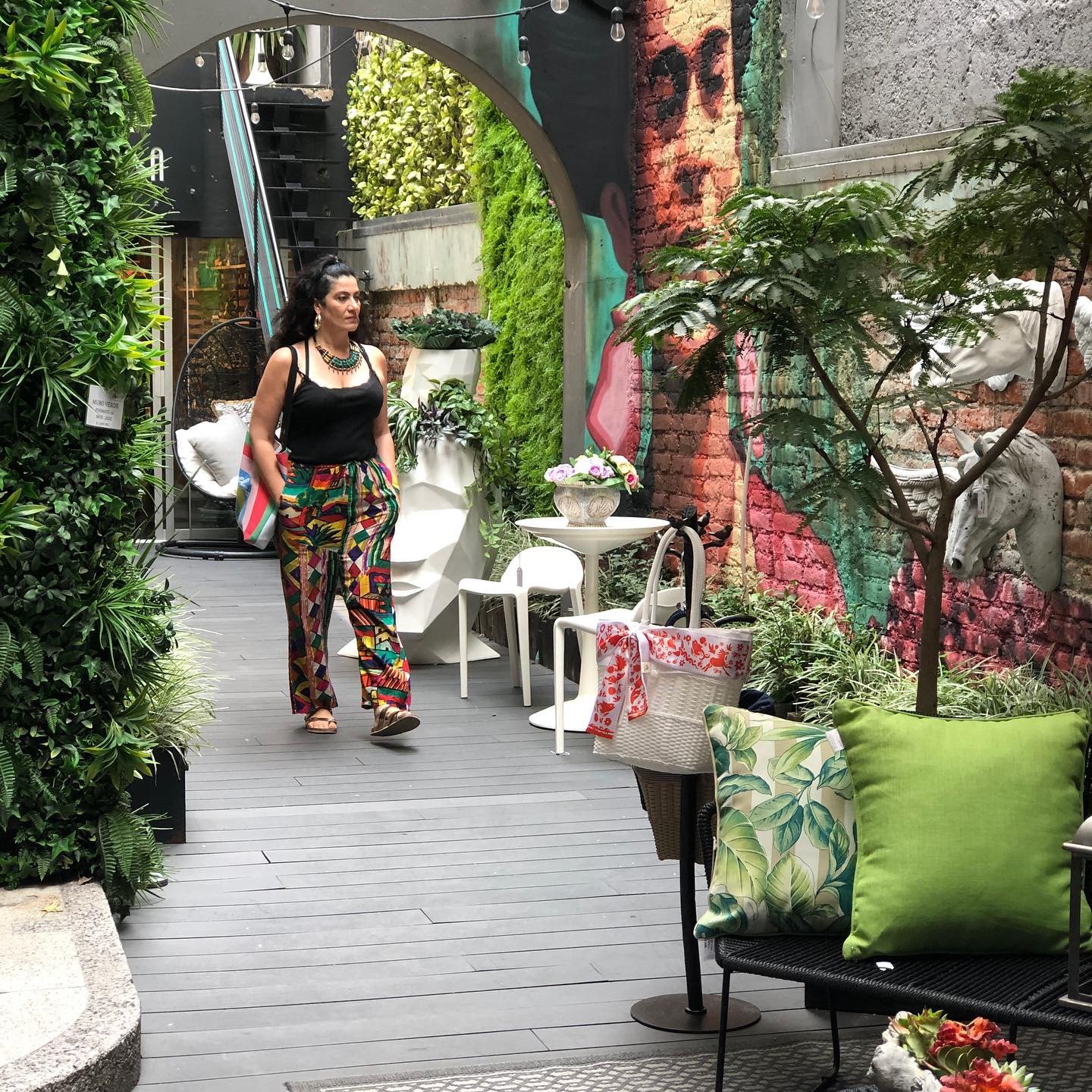
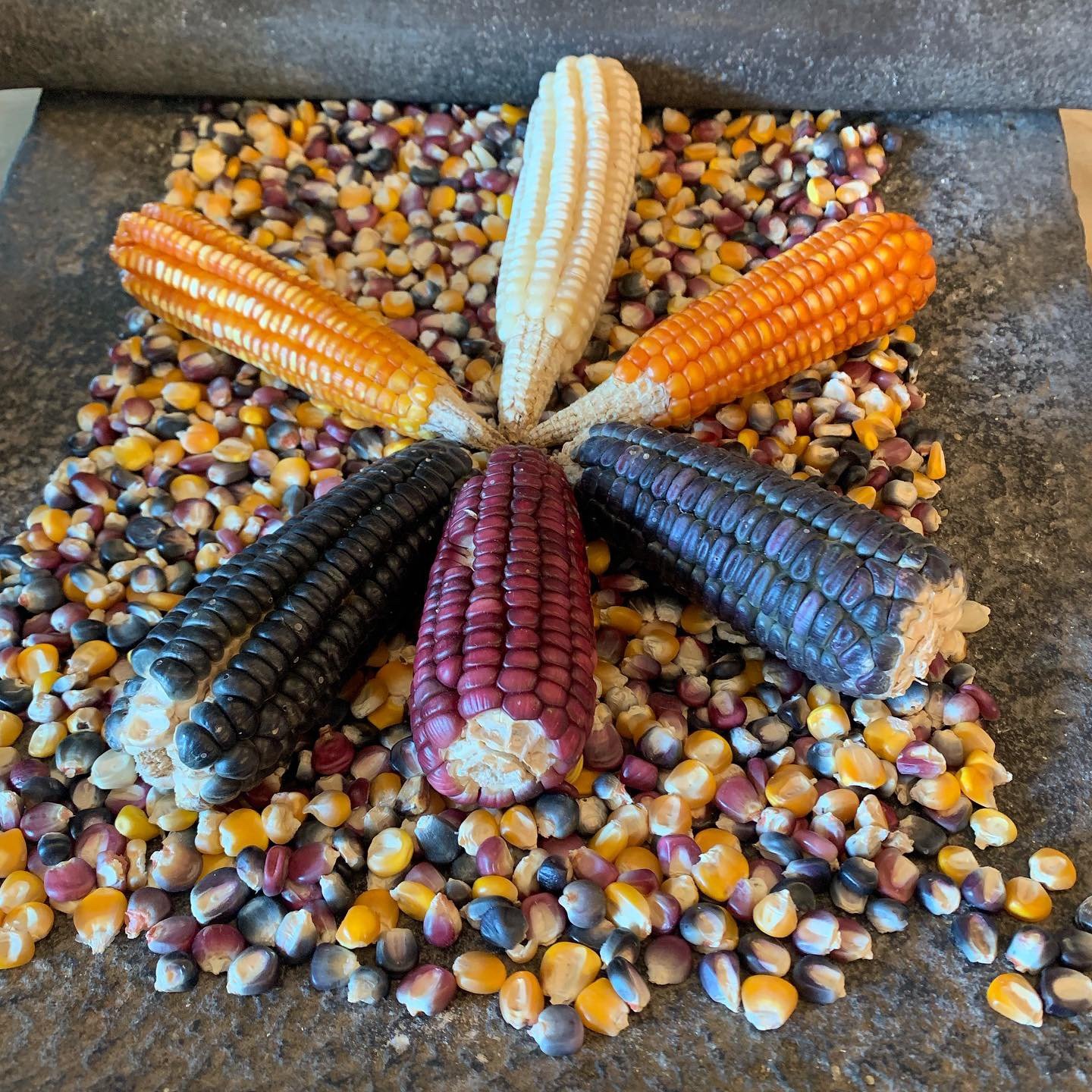
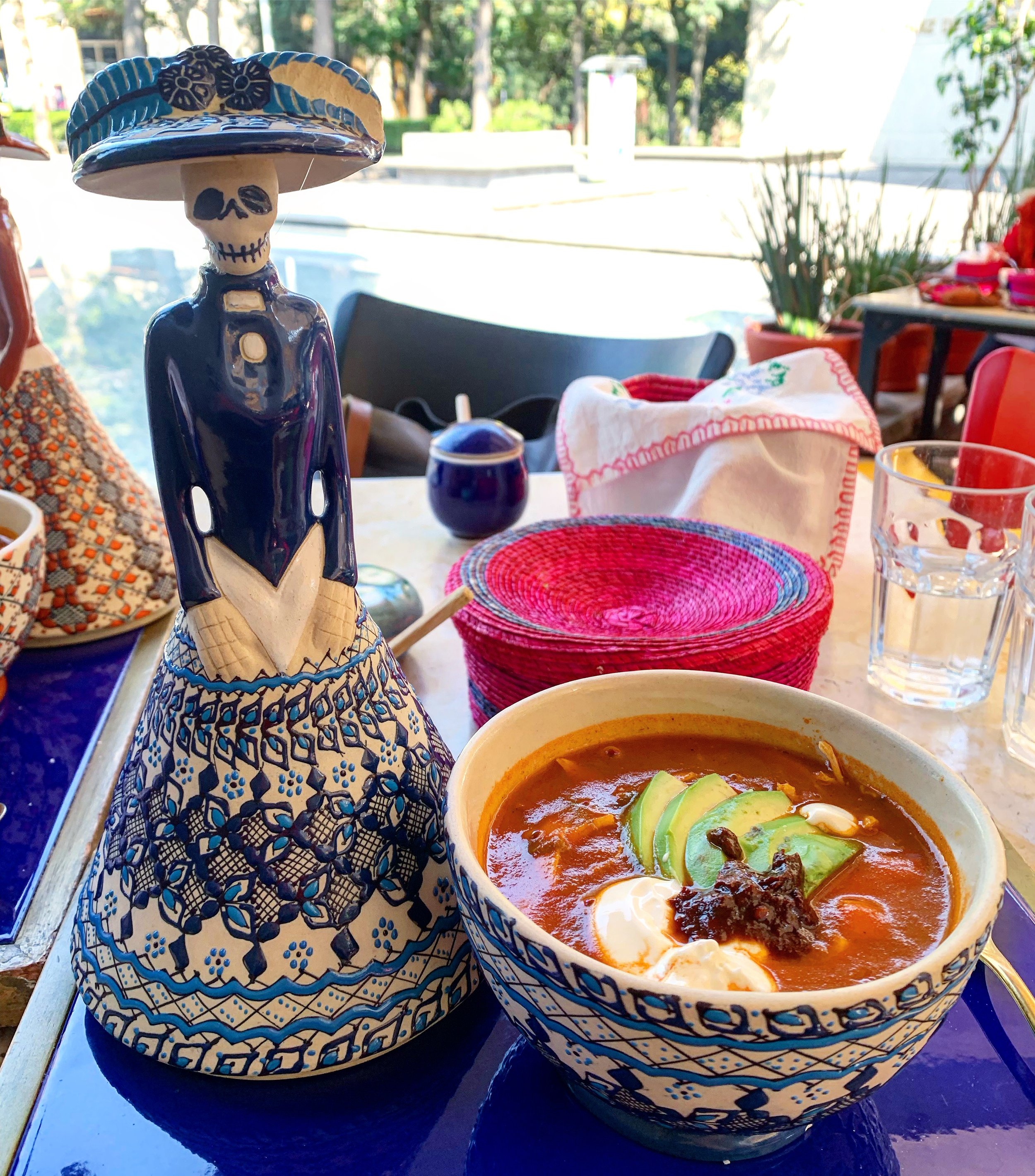
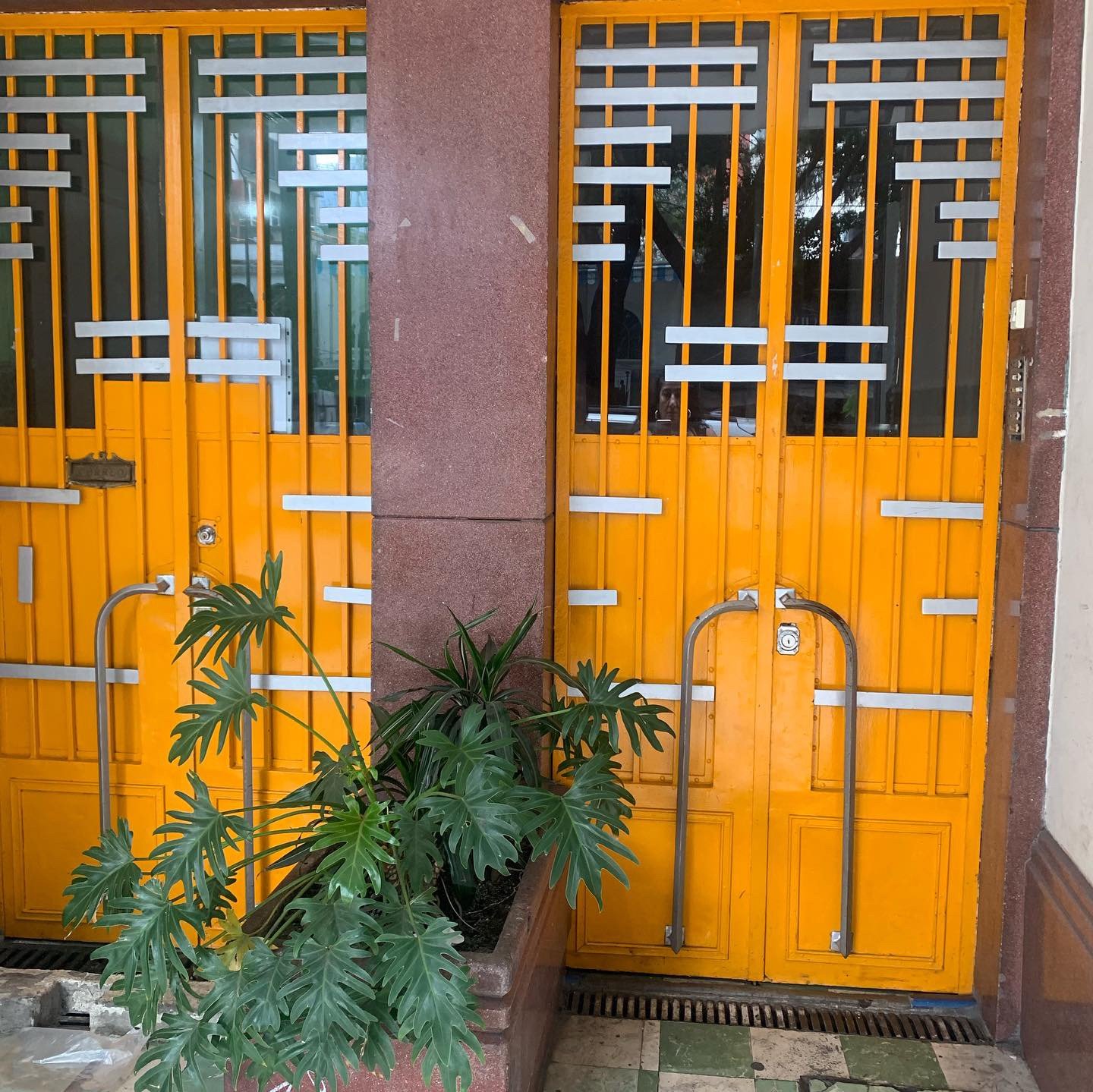
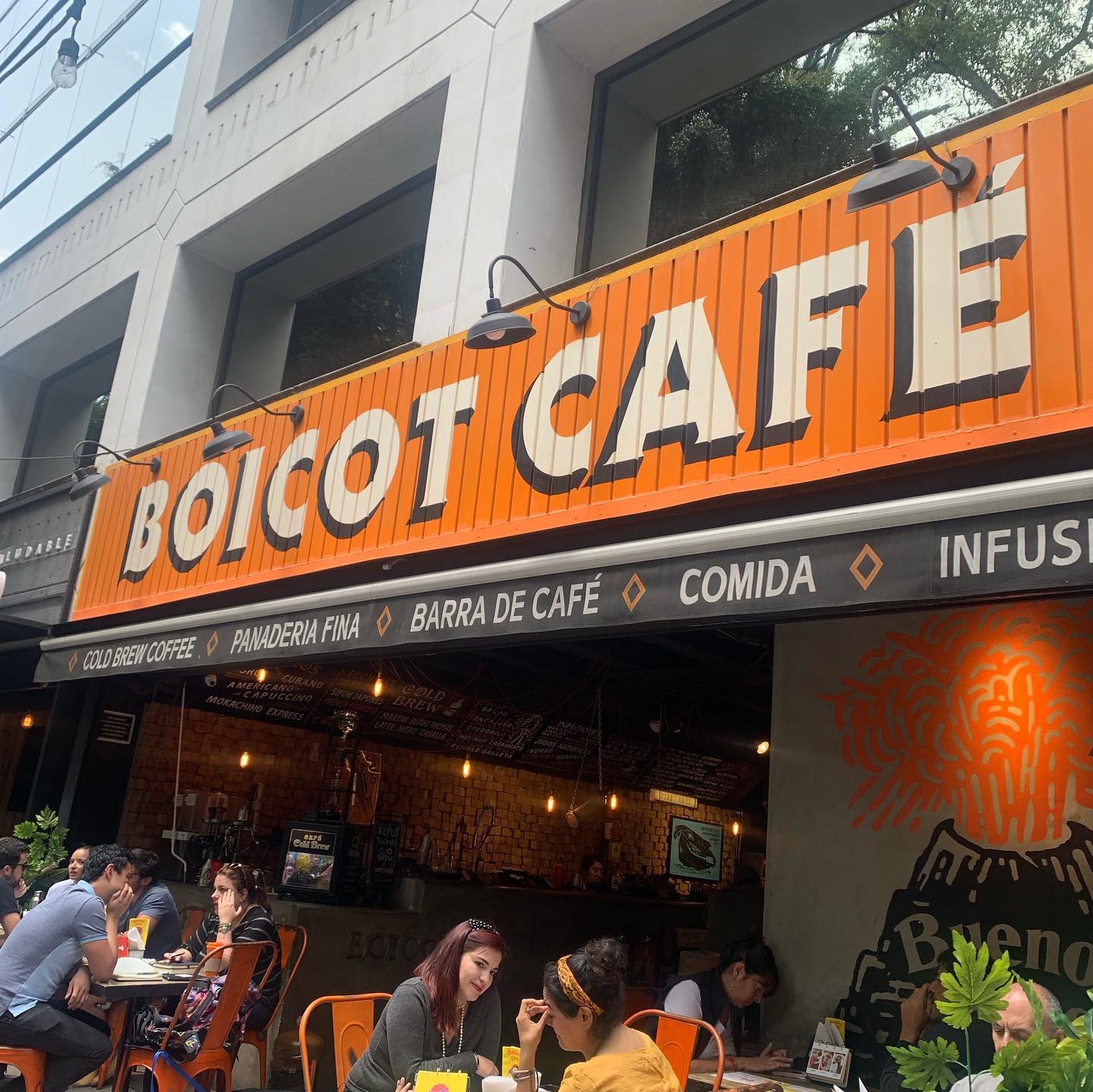
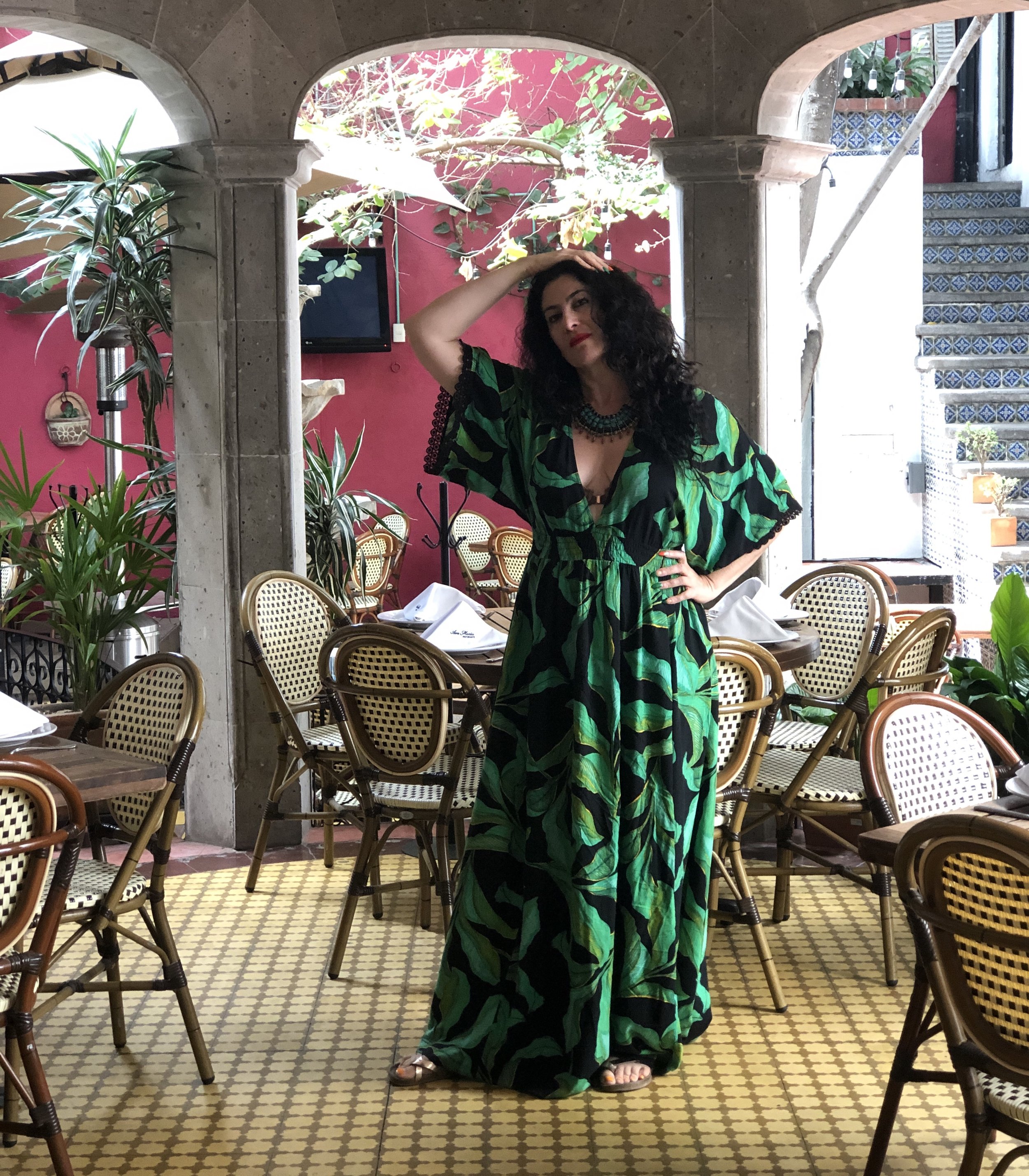
The smells of gasoline fumes and floral cleaning products mixed with that of onions and garlic frying and would waft into my nostrils as I headed out in the mornings to enjoy a cortado at a local cafe. I found myself back in the streets of Teheran, holding one of my parent’s hands as they walked me to preschool, stopping to get me a Persian orange-cardamom muffin (Cake Yazdi) on the way.
I also noticed that the architecture, graphics, posters and the overall design + creative vibe of the city reminiscent of the youthful and optimistic brilliance I saw in the pre-revolutionary design/art movements happening in Iran in the 1960’s and early 70’s.
I started to wonder if there were also any similarities in the foods and flavors of Persian and Mexican cuisine. Mexico has a long history of “Middle Eastern” culinary influence brought over first by the Spanish Conquistadors who colonized Mexico and whose own food was influenced by the Moors and Arab cultures; and then later with the immigration of Lebanese and Syrians in the 19th and early 20th century, resulting in some iconic dishes such as “Taco Al Pastor.”
But Persian cuisine is not the same as Arabic cuisine, though they share some similar cooking styles and ingredients. As far as I could tell, there had been minimal immigration or influence of Persian food and culture in Mexico and yet, everywhere around me I saw examples of how these two cultures would be a culinary and cultural marriage made in heaven.
The Creation of PÉRXICAN Spice Mix
And so, a couple years later, in the thick of the pandemic, I decided to take this time to make my tiny kitchen in the studio apartment I now called home my “spice lab” and start experimenting to figure out what the perfect marriage of spice and herbs from Mexican and Persian cultures would taste and look like.
My new home, which came to me as an unexpected blessing thanks to a dear friend who lives upstairs and gave me first dibs on her highly coveted rental unit, is in a highly Mexican/Latinx immigrant neighborhood of Highland Park in Los Angeles. I do not think this juxtaposition of me creating Persian food culture out of a Latinx neighborhood is a coincidence but instead, a nod and blessing from the culinary and culture goddesses and gods above.
The creation of PÉRXICAN spice mix allowed me to flex my culinary, design, art and storytelling muscles. The process of creating this layered seasoning that looks like art and has a label worthy of a designer perfume bottle is another talk show and I will write about that at another time.
For now what matters is that I birthed this gorgeous, aromatic, culturally-fluid food art project and now it is available for you to try and play around with in your own cooking. I call it an all-purpose seasoning because folks have been messaging me saying they literally use in all their dishes to boost the flavors of their cooking. I can tell you that I use this one bottle of seasoning as my own go-to for almost all of my everyday dishes as well.
What makes this so delicious and universally appealing? I have created an old-world, savory, aromatic blend that brings iconic Persian flavors like fenugreek, sumac and turmeric and enhances it with more smokey and peppery flavors of Mexican cuisine such as ancho chile peppers and smoked paprika. There are also herbs + spices that both cultures have in common such as cilantro and cumin, along with other spices that make this the most layered, delicious seasoning blend out there.
Explore PÉRXICAN for yourself
It has been a little over a year since I launched my Persian-Mexican, culturally-fluid spice blend! I love receiving messages and photos from folks who have given PÉRXICAN a try and are sharing their feedback and rave reviews with me!
If you are curious to try my hand-crafted spice blend for yourself, I now offer it both in its original layered bottle form and a new pre-mixed refill bag. I make these aromatic spices to order and infuse my love of culture and connection into each bottle and bag.
You can order your spices right here in my online shop and you can always message me here with any questions.
Nousheh Joon + Buen Provecho!
PÉRXICAN® SPICE BLEND: TIPS ON USING
Salam! Bienvenidos! Welcome!
Thank you for joining the PÉRXICAN® community of multi-cultural cooks, foodies, creatives and lovers of a spicy and layered life! .
WHAT IS IN THIS PERSIAN-MEXICAN SPICE BLEND?
I have thoughtfully created this aromatic, all-purpose seasoning to bring out some of the iconic flavors and aromas found in Persian and Mexica cuisines.
I hand-craft each bottle using ELEVEN HERBS + SPICES:
INGREDIENTS: TURMERIC, GARLIC POWDER, CUMIN, CILANTRO, FENUGREEK, ANCHO CHILE POWDER, SUMAC, PAPRIKA, PARSLEY, BLACK PEPPER, AND SMOKED PAPRIKA
HOW MUCH OF THIS SPICE BLEND SHOULD I USE IN MY DISH?
As a rule of thumb, I suggest using between 1/2 teaspoon - 1 teaspoon PER SERVING of whatever you are making. The bolder you like the flavor, the more you can use.
For example, if you are making a pot of soup/stew that makes 6 servings- use between 3-6 teaspoons of the PÉRXICAN® spice blend, depending on how much spice you like.
If you are making yourself breakfast tacos with two eggs, use 1/2-1 teaspoons of the spice blend
WHAT ARE SOME EVERYDAY DISHES I CAN USE THIS SPICE BLEND IN?
Below are some ideas for dishes you can use the PÉRXICAN® spice blend (and SALT) FOR THE PERFECT BALANCE OF FLAVORS.
I will be adding more ideas, recipes, videos and tips-this is just a start! I encourage you to experiment and try creating your own dishes with this blend!
BREAKFAST DISHES
All sorts of egg dishes including: breakfast tacos, scrambled eggs w/veggies, omelettes
Savory oatmeal with soft-boiled/poached eggs
Tofu scrambles
Savory waffles
MAIN DISHES
Perfect for stews, soups, Mexican caldos and Persian Khoreshts- use this spice blend instead of traditional seasonings
Use as a rub/seasoning for roasted or BBQ fish, chicken, lamb, beef
Pasta/red sauces will taste like they’ve been cooking for hours
Use instead of taco seasoning for your taco night or for fajitas, nachos, tostadas
Try seasoning your tamale fillings with this blend
Use in your next stirfry
SIDE DISHES
Toss with vegetables then roast in oven
Season your sweet potato fries
Use to make salad dressing-just add to your favorite oil/vinegar/lemon juice and blend
Add to labne/yogurt/sour cream to make a delicious dip
Use at the seasoning for hummus
WHERE CAN I GET MY HANDS ON THE PÉRXICAN® SPICE BLEND?
I am taking orders online and hand-crafting a batch every week. Click to here to go to my SPICE SHOP
A TECHNICOLOR HOLIDAY FEAST FOR THE PANDEMIC EYES
My victory stance after finishing installing this multi-media window art installation at the Third Street Promenade. Yes, I was recovering from an injury but I didn’t let that stop me!
When I think of “The Holiday Season”, I mostly have vivid childhood memories of feeling like an alien whose family didn’t have any traditions around decorating Christmas trees or lighting the menora; no memories of eating potato latkes or a Christmas ham, nor waiting in line to go sit on Santa’s lap.
Growing up in Arizona as an Iranian immigrant with moderate Muslim parents meant “The Holidays” became this time of year where the intoxicating displays of pageantry, consumption and revelry would tease and taunt me from every neighbor’s yard, every tv commercial and of course the neighborhood mall. The “Holidays” brought me deep feelings of not belonging, as well as a major case of FOMO.
Fortunately, my parents gave into my yearly campaigning to “get with the holidays” program and by the time I was in middle school, my siblings and I finally had the Christmas tree, gifts and stuffed stockings to look forward to (even if my family didn’t believe in Santa Claus).
Holiday dinners for us meant aromatic Persian home cooking like Ghormeh Sabzi or Khoreshteh Geiymeh and the iconic Tahdig crusty rice. If we were extra lucky, we might get my mom’s Sholeh Zaard (Saffron Rice Pudding) for dessert.
This memory of celebrating Christmas as Iranian Muslims, while eating traditional Persian food, is to me the epidome of where contemporary immigrant and Indigenous cultures have blended with traditional Eurocentric Judeo-Christian traditions to create today’s modern US culinary holiday traditions.
CONCEPT AND INSPIRATION FOR HOLIDAY FOOD ART INSTALLATION:
It is with this memory and lived experience that I was inspired to dedicate my current window art installation to honor some of the immigrant, Indigenous, and Black holiday food traditions of Los Angeles, a place I have called home now for a decade.
At a time when most of us cannot gather with our family and friends to share a holiday feast, it only seemed fitting that I should bring the “holidays” to my very intersectional and diverse community in the form of a technicolor feast for the eyes and soul.
As a hybrid visual artist/cook/storyteller with a strong social justice ethos, creating a multi-media window art installation at the Third Street Promenade in Santa Monica gave me the opportunity to challenge and flex all my skills and tell a story that many of us can relate to.
After doing some very unscientific research by holding some polls on my social media, I decided to focus on the following holiday dishes for my art installation: Tamales, an “Indigenous” Turkey, Matzo Ball Soup, Egg Rolls, Dumplings, New Year’s Gumbo, and a glorious Rainbow cake for dessert. Before my fellow Iranian/Persians ask me where the Sabzi Polo Mahi, Tahdig and the Aash Reshteh are….don’t worry..I got you covered in my Nowruz installation.
The Goddess of the Holiday Feast:
GODDESS OF THE HOLIDAY FEAST by Parisa Parnian
It is important for me to honor and acknowledge some of the matriarchal and pagan traditions that are the origins of what we know today as “The Holidays”. With that in mind, I envisioned the Goddess of the Holiday Feast to preside over the Feasting Table (which is also set up as a sort of altar.)
This Goddess is all about abundance, joy, sensual pleasures and the nourishment of our bellies and spirits with a splendid table of glorious culinary delights. She has four arms that allow her to both serve others the feast while also feeding herself. She symbolizes the balanced feminine that is both a giver and source of nourishment for others but is also able to feed and nourish her own body and spirit.
The Feasting Table and Altar
I wanted to create a visual feast/offering for my local community here in LA as well as my virtual community by creating a fantastical technicolor “feasting table” that utilizes my skills as a creative director, visual designer, culinary artist, and storyteller. The table is laden with surreal and colorful food art and sculptures that I created to represent the key multi-cultural holiday dishes I wanted to put a spotlight on.
Food Art Illustrations
As a backdrop to the Feasting Table, I created several new illustrations to spotlight some of the holiday dishes on the table: Tamales, Egg Rolls, Matzo Ball Soup and New Year’s Gumbo. Each illustration ties back into a food art sculpture on the table.
The Gumbo Goddess by Parisa Parnian. Art prints available online.
The Indigenous Turkey
As part of the holiday feast, I wanted to reimagine the turkey in hot pink with vividly colored, hand-painted markings that would give it a subversive, street art aesthetic. For me this turkey is my dedication to all my beloved friends who have Indigenous roots to Turtle Island aka “America”. It is also a dedication to all my Queer/Trans BIPOC (Black/Indigenous/People of Color) friends who know what it feels like to be different and othered and still choose to wear their stripes of many colors boldly on their skin.
Hnad-painted turkey sculpture as part of my art installation
Location and Details for the Holiday Food Art Installation
My art installation will be up until January 4th, 20201.
It is located in the former Barnes and Noble building on Thirst Street Promenade and Wilshire Blvd.
(For GPS purposes, put in the address to the Dr. Marten shop located next to my installation)
1215 Wilshire Blvd, Los Angeles, CA 90401
Closeup of my SAVAGE MUSE holiday window art installation at Third Street Promenade, Santa Monica.
Queer As A Pickle: Pickling as a Symbol of QTBIPOC Resilience
Let me start off by saying I am not an academic specializing in the field of Queer Studies nor am I an expert in the field of pickling. What I am is a forty-something Iranian-American queer designer, cook and storyteller who has been organizing fashion, culinary and performance events centering the distinctly “American Immigrant” queer/trans SWANA + POC experience since the late 90’s.
In the recent months, as the pandemic settled in and social distancing became the new normal, I, like many others, have tried my hand at pickling. Pickling seems like such a practical and necessary activity to partake in during a time when food insecurity, unemployment, mass protests around racial injustice and an uncertain future have taken center stage.
There is something so grounding and comforting in knowing that you can take a variety of nourishing vegetables/fruits/whatever and preserve them in a simple mixture of vinegar/water/spices to enjoy now as well as in the unknown future. It feels empowering and environmentally-minded to know that you can take produce that might be going bad and transform it into something delicious and waste-free.
What I didn’t expect was to begin viewing pickling as a symbol of QTBIPOC resilience.
Before I dive into my completely unscientific and unproven point of view around how pickling is QUEER AF, I will share with you a little insight into my early experiences with using the term “pickled”as a teenager growing up in an Iranian immigrant community in the late 80’s.
(CLICK HERE FOR PART ONE: THE SIGNIFICANCE OF BEING A SOUR IRANIAN WOMAN)
Fast-forward a few decades, a few major social/cultural/technological movements later and here we are in 2020. It is PRIDE month and “PRIDE” exists today because of riots & protests held by fierce and fearless American Black and other POC trans/queer folx who risked everything to stand up for the rights of the LGBTQ communties. Today we are in the midst of a country-wide and world-wide series of mass protests centered around Black Lives Matter, racial justice and the defunding of the barbaric and archaic police organizations in the US. We are still in the thick of the pandemic and it is unclear what the best protocol is to stay safe and stop the spread of the virus while also cautiously re-opening businesses and public spaces.
As shit continues to hit the fan, I find myself making more and more jars of pickles and reflecting. Spending time meditatively cutting an array of colorful ingredients, playfully arranging them in random glass jars, experimenting with different spices and vinegars to see what color and flavor the brine will become—these have become comforting activities for me during a time of great uncertainty as well as a time of collective growth in consciousness as a nation.
As part of my self-reflection during this pickle making, I started to see a poetic connection between the complex layers of being a person of the QTBIPOC experience and the act of pickling. I thought of how diverse and varied the shapes, colors, textures, and flavors are of pickled foods.
I thought of how transformative the pickling act is and how, depending on the the spices and brine used, the individual ingredients are reborn as a medley of delicious and layered flavors and colors. Let’s go beyond sour; let’s talk about tangy, spicy, sweet, bitter, aromatic, tart, bold, savory.
I thought of the sturdy cauliflower, the thirst-trappin’ eggplant, the high-femme watermelon radish, and the sexy hook-up of a beet and some turnips that magically turns them all a very gay fuschia pink color during the pickling process.
I thought of how the environment, in this case the brine, can directly effect how that jar full of ingredients starts to look and taste. Put too much sourness or bitterness into the jar and all the pickled pieces will start to take on that bitter and sour flavor. Add a drizzle of honey and some smoked paprika to the brine and that jar will have a subtly sweet and sultry vibe to it. The collective whole transforms and is effected by the balanced nature of its environment, in this case the brine.
Resilience. What does pickling have to do with QTBIPOC resilience? This theme came to me one day as I was digging around in my fridge to find produce that had started “going bad” or was “imperfect” in appearance. Imperfect ingredients with some bruises that were not “Instagrammable” in that flawless, white-washed way. I’d prefer to think of the aging produce as “seasoned”; the “imperfect” produce as perfectly unique in their beauty.
Instead of discarding these aging and imperfect produce, I saw the potential for what they could become if collectively they were given an optimal environment to transform into the most vibrant and delicious versions of themselves. I saw how coming together, these individual ingredients not only got more enhanced in their magnificence, but also now were going to last much longer, together in their communal brine.
Pickling these non-normative vegetables made me grin and think to myself of the expansive network of friends in my queer/trans community who each have shown endless strength, resourcefulness and vision in their own transformation and growth. It made me think of how many of my Black friends, SWANA friends, Indigenous friends, Asian friends, South-Asian friends, Latinx friends, and mixed race friends have forged ahead and created their own special “brines” and have been pickling up a storm with the community-building events, art, music and food they have been creating.
The act of pickling is an act of preservation, transformation and the enhancement of the collective pieces that come together as a whole in the same environment. I see more transformative and delicious new brine recipes coming out of our current circumstances. I see a whole new wave of pickling happening as we continue to show our resilience and resourcefulness.
HAPPY PRIDE!
CLICK HERE TO SEE MY FULL PICKLE-MAKING VIDEO!
"MAKE TAHDIG NOT WAR" TSHIRT AS SEEN ON TASTEMADE
You asked for it, so here it is: the “Make Tahdig Not War” T-shirt I made to wear on a special Tastemade cooking show I filmed last week (more details to come). I have made the T-shirt available for you in both short and long sleeves AND in white and black (because Persians, Goths, Punks and Queers all love their black).
CLICK HERE TO GO TO SHOP FOR SHORT SLEEVE TEES
Sizing:
Go with the “Men’s Tshirt” option which should really say unisex bc…gender is over, right? The “Women’s Fitted Tshirt” is being discontinued but it is still showing up on the site. Ignore it.
For sizing, if you usually wear “women’s sizes”, go one size down in the “Men’s sizes”. For example, if you wear a Women’s Large/XL, get a Men’s Medium.
Coming Out While Iranian: My Tastemade Cooking Show Debut
Can you imagine preparing, on camera, one of the most beloved and complexly nuanced/symbolic dishes of your country of origin—while sharing intimate and vulnerable details of not only your coming-out story, but of the subsequent challenges that have come with navigating the world of dating, family, and community as your intersectional queer self?
I was invited by Tastemade to take on this very unique challenge when I was asked to prepare Ghormeh Sabzi, one of the most iconic dishes of Iran (and dare I say the Persian Empire) while I shared stories about my journey as a queer, Iranian, Muslim-raised immigrant womxn.
This all came about when the Director of Original Series at Tastemade read the piece I wrote about coming out to my parents in the 90’s while cooking Ghormeh Sabzi (out of my tiny NYC kitchen) for a couple of queer Iranian friends who were visiting me from San Francisco. See full story here.
He invited me to come to Tastemade headquarters and do a full episode cooking show for a new series called Cooking With Pride, where I would share my stories with host Ingrid Nilson—while simultaneously showing her how to prepare Ghormeh Sabzi.
No. Big. Deal (!!!)
Ghormeh Sabzi is a very traditional Persian/Iranian dish that involves a lot of sophisticated and layered flavors from herbs such as fenugreek, parsley + cilantro; sour + earthy notes from fresh + dried limes (Limoo Amani) and spices like turmeric that meld together in a slow-cooked, savory and verdant stew that is served with a steaming plate of basmati rice.
For me, there was something poignantly symbolic about preparing this layered, complexly flavored, traditional dish on-air while discussing in detail some of the very complex, layered and vulnerable experiences I have had navigating the world as a queer, Iranian-American non-binary immigrant “outlaw” of sorts who came of age in the late 80’s/early 90’s within a tiny, Arizona-based Muslim community that was themselves considered “outlaws” by the larger Islamic communities and countries of the world.
During this cooking show, I share everything from my coming out story-to the awkward trauma around my first kiss—to where my desire has shifted to in terms of the gender(s) and orientation(s) I now date versus who I was dating in the early 90’s. All while preparing a dish that is a national treasure.
It has been a few weeks since the Tastemade “Cooking With Pride” episode I am on has aired. I have been surprised by the way the Iranian communities around the world have responded to this cooking show.
I have not received any negative or derogatory comments about the fact that I am a very out queer Iranian person who is not shying away from bringing visibility to folx like myself on shows like Tastemade. To me, this is HUGE and a sign that perhaps the collective conscience of the global Iranian communities are much more aware and accepting of the existence of Iranian LGBTQI within their local communities.
What I *have* been surprised by is the number of Iranians who have VERY PASSIONATELY engaged with the brief video clip posted on Tastemade’s Instagram page to proclaim that my Ghormeh Sabzi is not up to their standards and expectations (based on the brief clip showing how the dish was plated and presented on the show).
At first, I felt like I needed to explain to each Iranian viewer who commented that this is “TV” and that I didn’t literally whip up a complex dish that takes hours to cook in 21 minute…and that the finished dish they were criticizing so fervently was prepared by in-house chef/food stylists and shot for TV. Frankly, I thought the food stylist who prepared the pot of ghormeh sabzi for the camera did a fantastic job, considering it was her first time cooking a dish she had never seen or tasted before.
Once I got over the initial impulse to defend myself and the cooking show, I realized that the comments seem to come from a deep sense of pride and respect for the legacy of the Persian/Iranian culture and history. I was actually deeply moved by how strongly some Iranians felt compelled to police and criticize the way the Ghormeh Sabzi dish looked on air.
I know that for many Iranian families (including mine) who have had to flee their motherland for political and religious reasons, one of the only things they can hold onto and continue to nurture and pass on to the next generation(s) is the magnificent and unique Persian/Iranian culinary tradition.
For a scattered population of people, keeping the recipes and oral tradition of the motherland intact is equivalent to keeping the culture alive and well, despite wars, revolutions, displacement and reinventing yourself in a foreign land with foreign flavors.
I understand and have been deeply touched by all the Iranians (both living in Iran as well as the diaspora) who wanted to have their voices heard and who wanted to protect and honor the spirit of their motherland and history by commenting on the cooking video clip on Tastemade.
This only inspires me to want to create more cooking and culture videos where I can continue to explore and honor the stories, food and culture of a variety of intersectional people and communities around the world. Let us celebrate and keep alive the food, stories and heritage of our ancestors while we simultaneously showcase those individuals and movements today that are pushing boundaries and creating new language, culture and social movements.
TAHDIG FEAST ON MARCH 7TH
Announcing the first Persian Supper + Salon of the year: The “Make Tahdig Not War” dinner party!
Inspired by the t-shirt I created to wear on an upcoming Tastemade cooking show “Make This Tonight”, this special gathering will feature three different Tahdig dishes, including a special Iranian “Macaroni” Tahdig based off of a recipe of fellow Iranian chef/food blogger Omid Roustaei, aka The Caspian Chef
Check out the entire menu below and message me here if you would like details on how to book a seat. This is an intimate 12 person gathering, so space is limited!
MESSAGE ME HERE IF YOU WANT MORE DETAILS ON HOW TO BOOK YOUR SEATS!
This gathering is going to be held at the beautiful Los Angeles home of Iranian-American beauty, Leila Hamidi, who is an organizer + writer for the arts and architecture. She has graciously opened up her home to our gathering, as she wants to advance peace, love, and tahdig for all the peoples.
Want to reserve a seat for this dinner or have more questions? Message me here!
Want your own “MAKE TAHDIG NOT WAR T-SHIRT”? Check out my online shop and grab one for yourself here!
COOKING VIDEO: PARISA'S POTATO TAHDIG RICE ON SEVEN SPICE LIFE
Earlier this fall, I had the great pleasure of being a guest on a Seven Spice Life cooking video, showing the secrets to creating the PERFECT crunchy Potato Tahdig Rice. I had been introduced to Lisa Kiorkis, the talented Assyrian-American woman behind Seven Spice Life, last spring— thru a mutual friend who had a hunch we would have a lot in common and hit it off.
We both are first generation Middle-Eastern/SWANA women whose families live in Arizona. Lisa is currently based out of Phoenix, AZ where she is a boss babe entrepreneur who divides her time between the hair salon she runs with her sister and her work on Seven Spice Life. She has quickly become one of my favorite new people and I find her high-energy, passionate, hard-working and stylish vibe to be magnetic.
We had SO MUCH FUN creating this cooking video. I could seriously spend half my days in Lisa’s kitchen, cooking with her while we just chat about all sorts of subjects— from nerding out about cooking techniques to talking about our varied experiences navigating the world as queer middle-eastern women. The other half of my days, I would want to host delicious, fun, and engaging dinner parties and have guest chefs like Lisa bring their flavors, talents and stories to my dinner party guests.
In this cooking video, you can learn not only how to make my signature Potato Tahdig Rice with its perfect crunchy crust but you will also learn how to make Lisa’s quick and delicious Assyrian Chicken Curry Stew that pairs really well with this rice. For my vegetarian and vegan friends, you can create a vegetarian version of the Curry Stew by omitting the chicken, using vegetable stock, and increasing the quantity of vegetables you put in the stew.
I hope you enjoy this video as much as we enjoyed making it! By the time we finished cooking both dishes, the entire house smelled of fragrant and savory aromas and we were both drooling. Shortly after these shots were taken…we sat down and devoured this meal! Yes, we LOVE TO EAT as much as WE LOVE TO COOK!
I really am confident that if you follow the steps and techniques I highlight in the video on how to make the crunchy Tahdig Rice….that you too will get results like this. I would love to hear from you and see pics of your Tahdig Rice experiments.
Email me at: info@savagemuse or thru my IG: @savage_taste and send me pics of your Tahdig dishes!
NOUSHEH JAAN! BON APETITE! EAT WELL AND PROSPER!
SAVAGE TASTE FEATURED ON EATER LA!
I’m deeply honored to have my SAVAGE TASTE PERSIAN SUPPERS + SALONS featured on EATER LA!
Here is a link to the full article: https://la.eater.com/2018/11/28/18105614/savage-taste-queer-silver-lake-persian-dinner-popup-parisa-parnian-los-angeles
Message me HERE if you’d like to get on the invite list for future dinner parties and gatherings!
Closeup of me holding the Adas Polo (Lentil Rice with raisins + cranberries). This rice also has a potato “tahdig” which is the crusty rice developed at bottom of the pot. Photo: Meghan McCarron for la.eater.com
SAVAGE MUSE POP-UP DINNER SERIES
In addition my extensive background as a lifestyle/product designer & illustrator, I am also a passionate cook, event planner & hostess. I curate special dinners at my home in Silver Lake, where everything from the layout & styling of the tableware to the graphic design of the menu are part of my creative process.
Because I am a believer of the indoor/outdoor dining lifestyle, I am a big fan of beautifully designed melamine tableware that can be bold, colorful, memorable while also easy to handle and clean.
Having a moment of contemplation before my guests arrive for a recent SAVAGE MUSE POP-UP DINNER at my home in Silver Lake, Los Angeles.
Below is an example of one of the menus I designed for a POP-UP DINNER earlier this summer. I designed both the graphics/visuals/branding of the menu as well as designing the dishes and offerings on the menu.
Below are some more visuals from the events.
The Art of Creating Community Around a Queer Iranian Immigrant's Table.
This past Saturday, I hosted the second installment of a pop-up dinner party series at my home in Los Angeles. I was meeting and greeting all the dinner guests when one of them, who was a friend of a friend, asked me what the purpose of my dinner party was.
That question took me by surprise. I guess I just assumed everyone who had signed up to come to this gathering was looking to have a delicious culinary experience and maybe meet some new people. As I took a minute to gather my thoughts and respond to his question, I had to dig deep and ask myself what exactly the purpose of these dinner parties are.
A photo of me taken before guests began arriving on Saturday....the calm before the (awesome) storm of hostessing a dinner party! Photo credit: Tina June
Although I have made my living for the past 20 years as a fashion/ lifestyle designer and visual artist, cooking and feeding people has been a recurring theme in my life for as long as I can remember. As with many immigrant families, sharing a communal meal of large platters of food has been a part of my upbringing. It is one of the most significant and accessible ways for friends and family to experience a sense of abundance, even during the most difficult of times.
In my early childhood, my parents had lost all their wealth and possessions during the Iranian Revolution and had to start over in Arizona with only their talent and determination. I remember the joy of gathering around the dinner table for large platters of buttery, fluffy basmati rice and slow-cooked braised eggplant to ease and comfort us in our somewhat hostile and foreign environment (where our white Republican neighbors were both suspicious of and slightly fearful of us.)
Khoreshteh Bademjaan (Eggplant Braise) I made for my recent pop-up dinner. Photo credit: Tina June
Later in my young adult life, when I had moved to New York City in the mid 90's to study fashion at Parsons School of Design, I came out to my parents over the phone while stirring a pot of Ghormeh Sabzi to feed a couple of queer Iranian friends who were visiting me from San Francisco.
Ironically, I had been told that when a woman has mastered cooking this national dish, that she was ready for marriage. In my case, mastering Ghormeh Sabzi gave me the courage to come out as queer.
Ghormeh Sabzi (Persian Green Herb Stew) Photo and recipe at: Maman's Kitchen
Breaking bread and sharing the dishes of our motherlands became a big part of the underground queer Arab/Middle-Eastern/Iranian/SWANA scene back in the 90's and early 2000's as well. Long before we had social media to connect us, those of us who were part of these diasporas that had denied our queer/trans existence, were hosting dinner parties and potlucks in our humble apartments and walk-ups in Brooklyn, Queens, San Francisco, Oakland, and many cities in between. We shared stories of both the positive and sometimes devastating effects of our coming out to our respective families, as well as held space for those of us who were still living in the shadows that we called the closet.
Every dinner party starts with "breaking bread"-- in this case, with the delicious sourdough flat bread of Iran called "sangak".
I moved around a bunch in my twenties and thirties for my fashion/design career: from New York to Minneapolis and back to Brooklyn before moving West and spending some time in the Bay Area before making Los Angeles my home seven years ago. Every time I start over in a new town, my first impulse has been to build community by inviting folks over to my home for an authentic Persian/Iranian meal.
One of the dill & fava bean rice dishes I made for last Saturday's dinner. The crust is made with saffron, yogurt and potatoes embedded in the crunchy rice. In Farsi, this is called "Tahdig" which means "bottom of the pot". Photo credit: Tina June
Building community in LA has proven to be a completely different animal than what I have experienced in any other city I have lived in. Folks here are over-scheduled, over-worked, over-committed and have to factor in commutes, parking and geography every time they want to make a social commitment. People tend to congregate mostly with others who work in the same field as they do (read entertainment/movie industry). That organic way in which I have met and built friendships in other towns has proven to be rather ineffective in LaLa Land.
Table setting I designed for the SAVAGE MUSE pop-up dinner series. Pictured on the table are some of the "mezze" style appetizers: Naan'o'Panir (the Persian cheese and herb plate along with Sangak bread). Photo credit: Tina June
For me, creating these SAVAGE MUSE pop-up dinner parties is partly a way to bring together other folks who fall under the intersectional umbrella of mixed cultures, heritages, sexual and gender orientations, occupations and creative interests to come together and break bread together in a visually inviting, comfortable space.
Guests enjoying the "mezze" style appetizers in the outdoor garden area. Photo credit: Tina June
Later in the evening as the guests enjoy the main feast under the mid-summer night sky. Photo credit: Tina June
It is also partly a way for me to more fully express my potential as a lifestyle/brand designer, event creator, visual artist and creative director who can create a seamless brand from the menu design to the social media marketing to the table setting to who I staff and what food I cook and serve. Every aspect of these dinner parties is part of the "Savage Muse" philosophy and aesthetic.
Table setting I designed for the SAVAGE MUSE Pop-Up Dinners. Pattern-mixing, bold colors and textile prints from around the world are essential to the SAVAGE MUSE style. Photo credit: Tina June
The menu I designed for the SAVAGE MUSE Pop-Up Dinner series. I love playing with colors and taking visual design risks!
If you would like to get notified of upcoming SAVAGE MUSE events or read future posts and stories, subscribe to my newsletter at the bottom of this page or click here to send me your contact info. I hope to see you at a future SAVAGE MUSE event!








